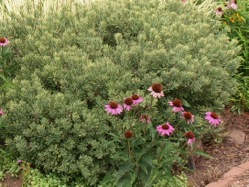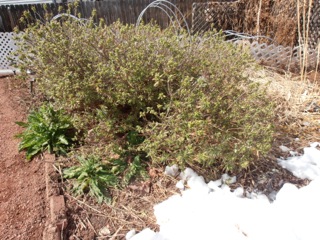 |
| Daphne in bloom in April, photo by Rebecca Anderson |
The daphnes (Daphne sp.) are a group of broadleaf shrubs that add interest to gardens around the world. There are nearly 100 species of daphne, which are in the same family as thyme (Thymeaceae). The most common species in the United States are the D. xburkwoodii, hybridized by British brothers Albert and Arthur Burkwood who were accomplished nurserymen in the 1920's. The 'Somerset' cultivar is the original popular variety. A beautiful mutation of 'Somerset' was discovered by New Jersey gardener Carol Mackie in 1962. Since then, the 'Carol Mackie' cultivar has been widely propagated. It is listed as hardy in zones 5 to 9, although many gardeners in zone 4 have had success. 'Carol Mackie' joined my flower bed in 2007 as an impulse purchase, and has really made herself at home since.
The soft round shape and variegated leaves were what caught my eye in the nursery almost a decade ago. The shrub features small oblong leaves that are green with a cream to gold margin. The leaves stay on the plant nearly year-round along the Front Range, making it a 3 to 4 season point of interest. In very cold winters the leaves will drop. That has only happened one year in the microclimate of my backyard since I planted 'Carol Mackie.' The shrub also grows slowly to a mature size of 3 to 4 feet tall with a similar diameter. Mine has maintained its dense, round shape with minimal pruning. There are mixed opinions about pruning daphne shrubs. The Royal Horticultural Society cautions against radical pruning of daphnes as they are prone to rot. Per their recommendations, pruning should be limited to removing damaged branches or minor adjustments to shape. In contrast, the University of Wisconsin Cooperative Extension recommends for the mature daphne, especially 'Carol Mackie,' to remove 25% of the mature wood annually after blooming. The shrub can be prone to breaking under heavy snow loads, so this may be one reason more aggressive pruning is recommended for our hemisphere.
 |
| Daphne in July with Echinacea, photo by Rebecca Anderson |
 |
| Daphne in late March, photo by Rebecca Anderson |
While the variegated leaves and soft shape of 'Carol Mackie' are nice additions to the landscape nearly year-round, she is a show-stopper in the spring when she blooms. 'Carol Mackie' is one of the earliest plants to bloom in the spring, providing early nectar for honey bees when little else is available. The pink flowers are tubular and highly fragrant, occurring in clusters similar to lilacs. They will have a second, less profuse bloom in the late summer on good years. Small red drupe berries will set in the fall. The berries are mild to moderately toxic, as are the leaves and bark. Ingesting large quantities of the berries can cause signs ranging from oral blisters to diarrhea and vomiting to, rarely, coma and death. The plant is reported to have a very bitter taste, which generally deters large ingestions. However, if you have a pet or family member who is an indiscriminate grazer, it might be best to select a different plant for the landscape. On the other hand, daphnes are reported to be "deer resistant" so the mild toxicity can be an advantage in some situations.
Daphnes are reported to be finicky shrubs to grow, at times perishing without any apparent reason. Fortunately no one has made my daphne aware of this as yet. They are prone to root rot, so it is key in our clay soils to make sure they have proper drainage. Amending the soil with organic matter and planting on a slope are beneficial. Once established, daphnes prefer not to have their roots disturbed, so moving mature plants will likely contribute to their demise. Over fertilization causes excessive growth that can be susceptible to disease and breakage. Benign neglect may contribute to overall success with these plants. Avoiding overwatering is important. The nursery where I purchased my daphne recommended treating her more like a cactus than a tender plant. This might be a little extreme, but I do have her on a drip irrigation system that meters out small amounts of water two times per week in the summer. Once established, these plants are fairly drought tolerant, a bonus in our arid climate.
 |
| Daphne 'Carol Mackie' in full bloom in April, photo by Rebecca Anderson |
If you find yourself needing to fill a 3 to 4 foot gap in a sunny to partially shaded area of your landscape, consider the daphne, especially 'Carol Mackie.' She'll add interest and beauty year round with minimal effort. For more information on these plants see the University of Wisconsin Cooperative Extension Service article. Another source is the Missouri Botanical Gardens website.




